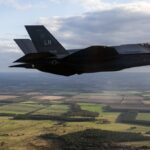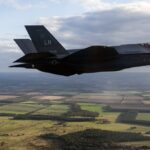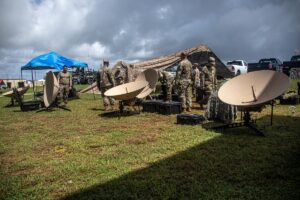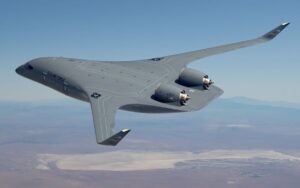
Air Force Secretary Frank Kendall, who spearheaded a two-year production pause for the U.S. Marine Corps’ version of the Lockheed Martin [LMT] F-35 as Pentagon acquisition chief during the Obama administration, said that he intends to study sustainment costs for the Air Force’s F-35A and to recommend ways to reduce them.
“We’ve got to work very hard to get improvement for the F-35A,” Kendall said in response to a question at a media roundtable on Sept. 20 at the Air Force Association’s Air, Space & Cyber conference. “The costs of sustainment have been high for a long time. We were able to drive them down to some extent before I left my old position, but there’s still a lot of room for improvement.”
“I don’t think, quite honestly, that we can get to the kinds of numbers that were talked about,” he said of the Air Force’s target of 1,763 F-35As. “I don’t think they’re realistic, frankly, but I think we can do a lot better than we are.”
The sustainment contract award is a stepping stone to a possible performance-based logistics (PBL) contract revision next year, if Lockheed Martin meets the CPFH, parts availability, and FMC rate goals.
The F-35 Joint Program Office (JPO) and Lockheed Martin have declined to release the cost per flight hour, parts availability, and FMC targets that Lockheed Martin is to meet for fiscal years 2021, 2022, and 2023, and Defense Daily has filed a Freedom of Information Act to obtain those records. The Pentagon has not typically released the terms of its awarded contracts, apparently due to concerns about the disclosure of classified and company-proprietary data.
“I have not had a chance to look at what the targets are for Lockheed in this most recent contract,” Kendall said on Sept. 20. “I will be doing that. I have not had a chance to look in detail at the program office’s plans…I will be doing a deep dive on the F-35. I will be looking specifically at sustainment costs and what we can do to get the numbers down there. I am a big believer in putting financial pressure on people and creating strong incentives. I hope this deal we just did puts some strong incentives on Lockheed.”
While past F-35 sustainment contracts evaluated Lockheed Martin on the aircraft’s mission capable rates, the new sustainment contract is to judge the company on FMC rates and the on-time availability of parts to ensure FMC rates improve. Overall, the Government Accountability Office has said that the F-35’s FMC rate is 54 percent–18 points below the goal.
The F-35 JPO has said in the past that FMC rates depend on sufficient investments by the Air Force, U.S. Navy and Marine Corps in spare parts and flying hours.
“Under this contract, the cost per flight hour (CPFH) for the global fleet improves by 8% from $36.1K in 2020 to $33.4K in 2023, in constant year 2012 dollars,” the F-35 JPO has said of the new sustainment contract. “Specifically, this represents a $3.6K reduction in CPFH for the USAF A-model from $33.6K in 2020 to $30.0K in 2023. The contract also drives improvements to performance through a refined performance incentive structure focused on year-over-year improvements in full mission capable (FMC) rates and supply metrics.”
While the $30,000 CPFH target for the Air Force F-35A is a goal, factors could intervene that could make that goal more difficult to achieve, such as a change in requirements, rising fuel costs, or the establishment of a program for an additional or alternate engine beyond the existing Pratt & Whitney [RTX] F135 engine.
Lockheed Martin has said that the fiscal 2021 through 2023 sustainment contracts “include an incentive structure for meeting both cost and performance objectives.”
“If Lockheed Martin does not meet the contract objectives, incentive payments are reduced accordingly,” the company said.
The three-year sustainment contract “incentivizes Lockheed Martin to deliver Full Mission Capable (FMC) rates for the F-35A, F-35B and F-35C,” per Lockheed Martin. “It also incentivizes Lockheed Martin to improve supply availability and ensure parts are delivered with required Electronic Equipment Log (EEL) data.”
Lockheed Martin has said that it has invested $500 million in cost reduction initiatives for its 40 percent of the F-35 sustainment program. Pratt & Whitney and the government make up the remaining 60 percent of the sustainment program.
Air Force Gen. Mark Kelly, the head of Air Combat Command (ACC), said last February that he is not confident that the F-35 will reach a program “25 by 25” goal of $25,000 CPFH by 2025 (Defense Daily, Feb. 26).
In the past two years, Pentagon officials, including those from the Cost Assessment and Program Evaluation (CAPE) office, have voiced similar skepticism about reaching the $25,000 goal. In the summer of 2020, the F-35 JPO said that the CPFH overall was $35,000, down from $44,000 in 2019.
Lockheed Martin CEO James Taiclet told defense analysts during a second quarter earnings call in July that the government, Lockheed Martin, and Pratt & Whitney have to be “all in” to meet the “25 by 25” goal.
While House Armed Services Committee Chairman Adam Smith (D-Wash.) has suggested reducing the F-35 buy significantly, Kendall suggested on Sept. 20 that there are no viable alternatives that would match the F-35A’s loss-exchange ratios in combat.
“There are always alternatives, in a sense, but the F-35A is such a superior platform operationally that its value is very high, compared to its costs,” he said. “If you look at exchange ratios, for example, it performs incredibly well, especially against higher end threats. We need an F-35, but we need one we can afford.”
On Sept. 20, Air Force Lt. Gen. Clinton Hinote, the service’s deputy chief of staff for strategy, integration, and requirements, said that Kelly had told him last week that 46 of the Air Force’s 297 F-35As– more than 15 percent–are grounded for engine or engine-related needs, parts or fuel systems, including engines that have not completed depot maintenance.
“That’s not acceptable,” Hinote said. “We have got to do better.”













